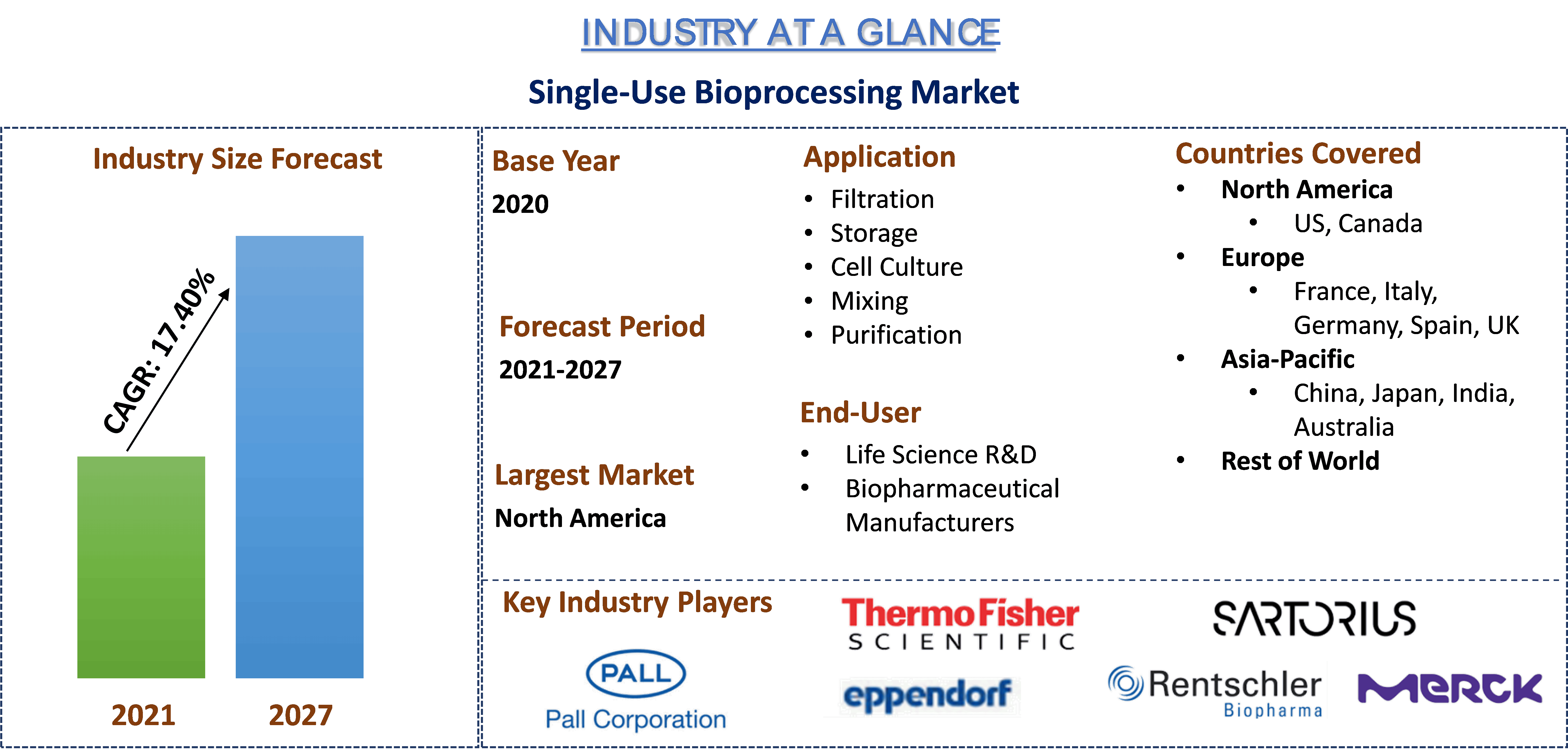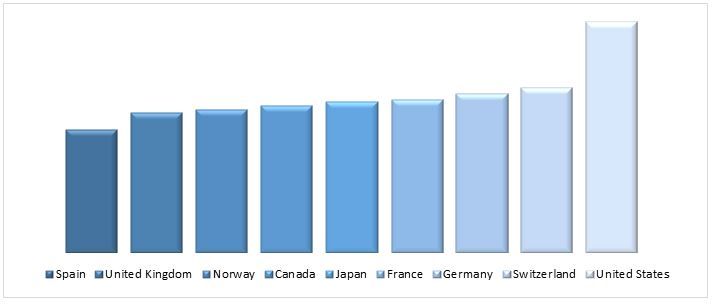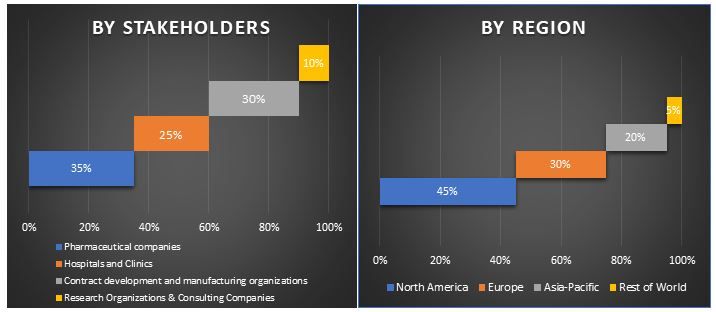
一次性系统是只使用一次然后丢弃的生物制药生产(生物加工)产品。一次性系统通常由经过消毒并使用伽马射线辐照密封的塑料组件组成。慢性疾病的患病率在全球范围内持续上升。它们是世界主要的杀手,占所有死亡人数的 63% 以上。如果不采取任何措施来扭转这一趋势,未来十年内死于慢性疾病的人数将增加 17%。 这导致扩大临床研究活动以破译生物治疗药物对抗各种疾病领域的潜力,预计将对一次性生物加工市场产生积极影响。
由于与传统生物加工技术相比具有许多优势,生物制药公司的一次性生物加工预计未来将实现健康扩张。这些技术具有多种优势,包括较低的初始投资和研发成本、较低的劳动力和材料成本以及易于处理。此外,与传统生物加工中使用的不锈钢反应器相比,这些一次性生物加工装置的二氧化碳平衡提高了 35%,这就是它们被制造商广泛使用的原因。 默克 KGaA 宣布在 2018 年在亚洲额外投资 4000 万欧元,为期两年,以建立稳固的制造和分销网络。
此外,越来越多的药物和其他生物制剂的批准增加了对一次性耗材(如培养基袋和容器)的需求。药物评估和研究中心 (CDER) 在 2020 年批准了 53 种新药。(CDER)。每年,FDA 批准的新药物品数量波动很大:2016 年,仅批准了 20 多种新药,而 2018 年,批准了近 60 种新产品。2020 年,批准了 53 种新药。2019 年,许多新药将得到开发,尤其是在美国的制药业务中。仅在美国,截至 2019 年 4 月,就有近 1100 种针对癌症和癌症相关疾病的新型药物正在开发中。 还有数百种针对罕见疾病、神经系统疾病和皮肤病的新型疗法也在开发中。
国民医疗保健支出,占 GDP 的百分比
赛默飞世尔科技公司、默克 KGaA、赛多利斯股份公司、康宁公司、颇尔公司、通用电气公司(GE 医疗保健)、艾本德股份公司、Rentschler Biopharma SE、龙沙和迈斯纳过滤产品公司是在全球一次性生物加工市场运营的一些主要参与者。这些参与者已进行多次并购以及合作,以向客户提供高科技和创新产品。
报告中提出的见解
 根据产品类型,市场分为培养基袋和容器、过滤组件、一次性生物反应器、一次性混合器等。培养基袋和容器细分市场在 2020 年占据了市场的主导地位,市场份额为 XX%,并且由于在运输和存储中越来越多地采用培养基袋和容器,预计将在预测期内保持其主导地位。
根据产品类型,市场分为培养基袋和容器、过滤组件、一次性生物反应器、一次性混合器等。培养基袋和容器细分市场在 2020 年占据了市场的主导地位,市场份额为 XX%,并且由于在运输和存储中越来越多地采用培养基袋和容器,预计将在预测期内保持其主导地位。
在应用中,过滤细分市场占据主要份额”
根据应用,市场分为过滤存储、细胞培养、混合和纯化。过滤细分市场在 2020 年占据了市场的主导地位,收入为 XX 亿美元,预计将在分析期间保持其主导地位。此外,预计该细分市场在此期间也将以最高的复合年增长率增长。
根据最终用户,市场分为生命科学研发和生物制药制造商。2020 年,生物制药制造商占最大的市场收入份额 XX%,预计在分析期间仍将占据主导地位。
“北美是单次使用生物加工市场的最大市场之一”
为了更好地了解一次性生物加工市场的市场动态,我们对全球不同地区进行了详细分析,包括北美(美国、加拿大和北美其他地区)、欧洲(德国、法国、意大利、西班牙、英国和欧洲其他地区)、亚太地区(中国、日本、印度和亚太地区其他地区)、世界其他地区。由于慢性疾病的患病率增加和 COVID-19 的爆发,北美地区占据了市场的主导地位,并在 2020 年创造了 XX 亿美元的收入。北美政府一直在大力投资开发 COVID-19 疫苗、治疗方法和诊断测试,预计这将增加对一次性生物反应器的需求,从而促进整体市场增长。
购买本报告的理由:
- 该研究包括经过认证的主要行业专家验证的市场规模和预测分析
- 该报告一目了然地快速回顾了整个行业绩效
- 该报告深入分析了杰出的行业同行,主要关注关键业务财务、产品组合、扩张策略和最新发展
- 详细研究行业中存在的驱动因素、限制因素、主要趋势和机遇
- 该研究全面涵盖了不同细分市场的市场
- 深入分析行业区域层面
定制选项:
一次性生物加工市场可以根据要求或任何其他细分市场进一步定制。除此之外,UMI 了解到您可能有自己的业务需求,因此请随时与我们联系以获取完全适合您需求的报告。
目录
分析全球一次性生物加工市场的历史市场、评估当前市场以及预测未来市场,是创建和分析全球主要地区不同疾病采用一次性生物加工技术的三大主要步骤。我们进行了详尽的二级研究,以收集历史市场数据并评估当前市场规模。其次,为了验证这些见解,我们考虑了大量的发现和假设。此外,我们还对一次性生物加工行业的价值链上的行业专家进行了详尽的一级访谈。在通过一级访谈对市场数据进行假设和验证后,我们采用了自上而下/自下而上的方法来预测完整的市场规模。此后,我们采用了市场细分和数据三角测量方法来评估和分析行业相关细分市场和子细分市场的市场规模。详细的方法论如下所述:
历史市场规模分析
步骤 1:深入研究二级来源:
我们进行了详细的二级研究,通过公司内部来源(例如年度报告和财务报表、业绩演示文稿、新闻稿等)以及外部来源(包括期刊、新闻和文章、政府出版物、竞争对手出版物、行业报告、第三方数据库和其他可信出版物)来获取一次性生物加工的历史市场规模。
步骤 2:市场细分:
在获得一次性生物加工市场的历史市场规模后,我们进行了详细的二级分析,以收集主要地区不同细分市场的历史市场见解和份额。报告中包含的主要细分市场包括疗法、应用和最终用户。此外,我们还进行了国家/地区层面的分析,以评估每个地区一次性生物加工技术的总体采用情况。
步骤 3:因素分析:
在获得不同细分市场和子细分市场的历史市场规模后,我们进行了详细的因素分析,以评估一次性生物加工技术的当前市场规模。此外,我们使用诸如癌症发病率增加和老年人口增长等因变量和自变量进行了因素分析。我们对需求和供应侧情景进行了全面分析,考虑了全球一次性生物加工行业中的顶级合作、并购、业务扩张和产品发布。
当前市场规模评估与预测
当前市场规模评估:基于上述 3 个步骤的可行见解,我们得出了当前市场规模、一次性生物加工市场中的主要参与者以及细分市场的市场份额。所有必需的百分比份额拆分和市场细分均使用上述二级方法确定,并通过一级访谈进行了验证。
评估与预测:对于市场评估和预测,我们为包括驱动因素和趋势、限制因素以及利益相关者可获得的机会在内的不同因素分配了权重。在分析这些因素后,我们应用了相关的预测技术,即自上而下/自下而上的方法,以得出到 2027 年全球主要市场不同细分市场和子细分市场的市场预测。用于评估市场规模的研究方法包括:
- 该行业的市场规模,就价值(美元)和国内主要市场一次性生物加工技术的采用率而言
- 市场细分和子细分的全部百分比份额、拆分和细分
- 就所提供的服务而言,一次性生物加工市场中的主要参与者。此外,这些参与者为在快速增长的市场中竞争而采取的增长战略
市场规模和份额验证
一级研究:我们与主要地区的关键意见领袖 (KOL) 进行了深入访谈,包括高级管理人员(CXO/副总裁、销售主管、营销主管、运营主管和区域主管、国家/地区主管等)。然后对一级研究结果进行总结,并进行统计分析以证明所陈述的假设。一级研究的输入与二级研究结果合并,从而将信息转化为可行的见解。
不同地区一级参与者的划分
市场工程
我们采用了数据三角测量技术来完成整体市场评估,并得出一次性生物加工市场每个细分市场和子细分市场的精确统计数字。在研究了一次性生物加工市场的产品、应用和最终用户领域的各种参数和趋势后,我们将数据分为几个细分市场和子细分市场。
一次性生物加工市场研究的主要目标
该研究指出了当前和未来的一次性生物加工市场趋势。投资者可以从研究中执行的定性和定量分析中获得战略见解,从而为他们的投资判断提供依据。确定当前和未来市场趋势后,可以了解区域层面的市场总体吸引力,从而为行业参与者提供一个平台,以利用未开发的市场来获得先发优势。该研究的其他定量目标包括:
- 分析一次性生物加工的当前和预测市场规模,就价值(美元)而言。此外,分析不同细分市场和子细分市场的当前和预测市场规模
- 研究中的细分市场包括产品、应用和最终用户领域
- 定义和分析一次性生物加工行业的监管框架
- 分析涉及各种中间机构的价值链,以及分析行业客户和竞争对手的行为
- 分析主要地区一次性生物加工市场的当前和预测市场规模
- 报告中研究的主要地区包括北美(美国和加拿大)、欧洲(德国、法国、意大利、西班牙和英国)、亚太地区(中国、日本、印度和澳大利亚)以及世界其他地区
- 一次性生物加工公司的公司简介以及市场参与者为在快速增长的市场中保持发展而采取的增长战略
- 深入分析该行业的区域层面
相关 报告
购买此商品的客户也购买了












